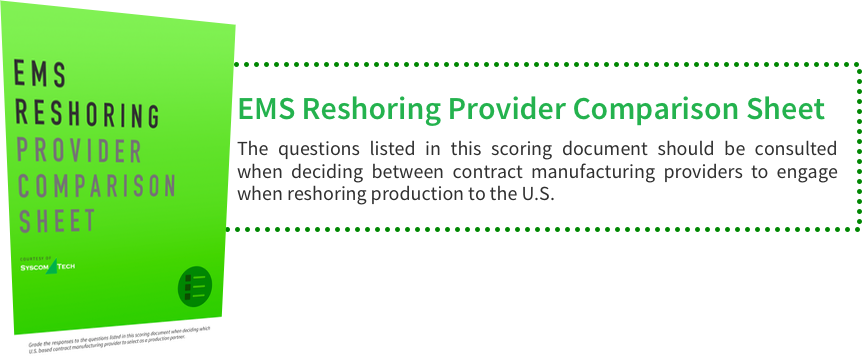On the heels of the 2016 Presidential election, offshoring is losing its favorability with manufacturers. Many industry giants are pushing for the reshoring of their operations back to American soil in response to signals that the government will reward domestic manufacturers by imposing taxes on companies that offshore their production. Apple recently approached two of its biggest Japanese manufacturing partners – responsible for a large portion of the company’s iPhone assemblies– to explore ways to move production operations to the United States. Their foremost competitor, Samsung, is considering building a U.S.-based plant for its home appliance assemblies. Ford, GE, and Google have already begun reshoring initiatives of their own.
Some critics are skeptical that the benefits of onshoring will outweigh projected increases in production costs – nearly 50% of Apple’s part suppliers are located in Asia – but with mounting pressure to support domestic manufacturing, and looming threats of doing nothing, contract manufacturers (CMs) and original equipment manufacturers (OEMs) are more critically assessing conventional wisdom. Since the late 1970s, American manufacturers have moved operations abroad in search of cheaper labor, looser regulations, and lower costs. Advancements in technology and globalization only added to the momentum of this trend in the 1990s and early 2000s. So what about reshoring is causing OEMs to think twice?
Making A Business Case for U.S. Reshoring
What many OEMs have come to find is that, although the initial overhead equipment and labor costs of offshore manufacturing appear low, there are often multiple hidden costs that companies don’t discover until it’s too late. Many of the benefits that offshoring once promised to OEMs are now actually contributing to a higher Total Cost of Ownership (TCO).
These 5 key factors are making U.S. reshoring more financially viable:
1. Increased Total Cost of Ownership (TCO): Rising labor rates paired with hidden costs such as an increased risk of intellectual property loss, frequent miscommunication, and unreliable product quality (consider the ramifications of counterfeit components in military applications), ultimately result in a higher TCO, countering the expected savings of offshoring.
2. Changing consumer preferences: Boston Consulting Group recently reported that concerns over product quality and supporting the U.S. economy have caused an uptick in consumer preferences for products made in the USA. In fact, over 80% of U.S. consumers stated they would be willing to pay more for products labeled “Made in USA” than for those labeled “Made in China.”
3. Rising wages in Asia: Labor wages have increased worldwide—by 500% in the last 12 years, and by 18% per year in China specifically.
4. Additional overlooked costs: When it comes to offshoring, supply chain managers must consider the high transportation costs and long lead times associated with shipping products back to the U.S. for American consumption, as well as the import fees and supplier visits incurred by overseas manufacturing. The company is also at risk of other “soft costs” that could result from missed revenue recognition, late customer deliveries, and/or poor product quality. A recent survey analysis from Accenture revealed that manufacturing executives significantly underestimate overseas manufacturing costs.
5. Supply chain flexibility: With the recent explosion in automation, production processes are moving at quickening speed. By reshoring these operations closer to end users, manufacturers create a leaner supply chain that’s better suited for rapid production. A hybrid approach of “source globally, assemble locally,” can shorten the supply chain, enable flexibility in customization, free up more capital, and expedite product entry to market.
Many of the biggest names in manufacturing are already executing plans to reshore their production operations. While OEMs are still weighing the pros and cons of reshoring back to the U.S., a small portion of contract manufacturing providers maintained domestic operations at the height of offshoring’s popularity.
Syscom Tech is proud to have remained U.S.-based since our inception in 1998.
Contract manufacturers who have been U.S.-based for extended periods of time provide OEMs with the competitive advantages of an operationally efficient supply chain and well established relationships – and prices – from part suppliers. If you’re looking to develop a new product, consider working with our U.S.-based manufacturing team for optimal innovation, production and supply chain efficiency.

